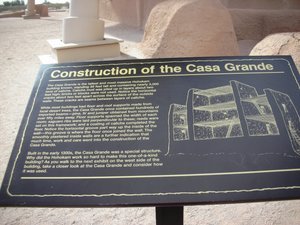Advertisement
Published: January 12th 2009

 Artist
Artist
This shows the National Park's idea of what the Great House looed like around 1200. This is the largest structure know to exist in Hohokam times. Casa Grande is about 60 miles east of Phoenix, Arizona. One of the membership parks is there and since I wanted to leave my motor home in a secure place while I went to spend Christmas with the family it was ideal.
I liked Casa Grande although there isn’t a heck of a lot there. The town is laid out over a large area; all of the gardens of course require low or no water supply. There is a Super Wal Mart and an outlet mall—who could want more? The RV Park was very nice, lots of activities and meals served almost every night. Unfortunately my wireless connection was the absolute “PITS!” Very frustrating! I went to the public library to send the one email I did get out.
Casa Grande is home to the National Park’s Casa Grande Ruins. The American Indians who inhabited Arizona had tremendous challenges regarding their water supply but they also had great ingenuity. They were the first to use caliche which is a mixture of sand, clay and calcium carbonate and is found in the subsoil; mixed with water to make it pliable, when it dries the mixture becomes like concrete. The Southern Sinagua Indians

 Great House
Great House
Known as the Great House this four story structure is also built out of caliche. The builders knew very well the ways of the land and would gather inside to view the heavens. Knowing the changing positions of celestial objects meant knowing times for planting, harvest, and celebration.had occupied much of the area around Camp Verde and it is thought that when they disappeared in the 1400s they melted into the Hohokam; a word that actually means “all-gone” or “all used up.” The Hohokam thrived in the Gila River Valley around here for more than a 1000 years, hunting and gathering, building canals to irrigate their crops and building structures from caliche. Villages stood along natural routes so the Hohokam could trade their pottery and jewellery with travelers. Shells from the Gulf of California, coins, mirrors, and copper bells, probably from Mexico have all been found here. However as with the Sinagua, the Hohokam people disappeared without explanation. In 1694 Father Eusebio Kino and his party of missionaries found an empty shell of the once-flourishing village. In 1892 Casa Grande became America’s first archeological preserve.
Advertisement
Tot: 0.225s; Tpl: 0.01s; cc: 15; qc: 75; dbt: 0.0749s; 1; m:domysql w:travelblog (10.17.0.13); sld: 1;
; mem: 1.2mb

 Artist
Artist
 Great House
Great House








